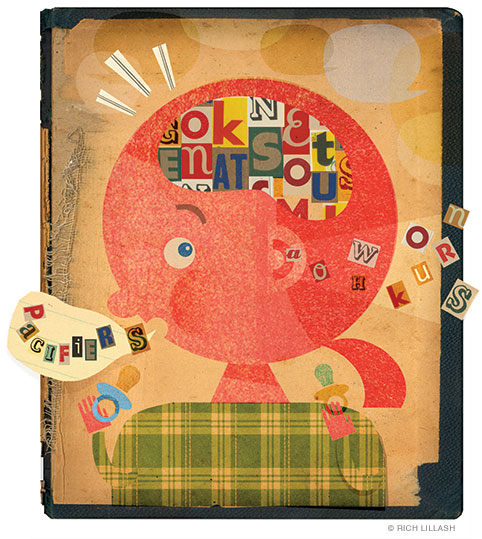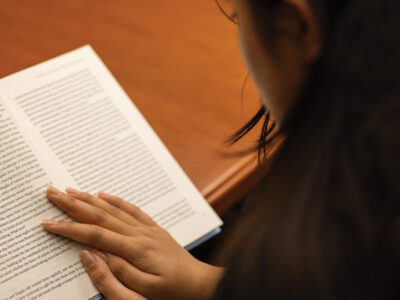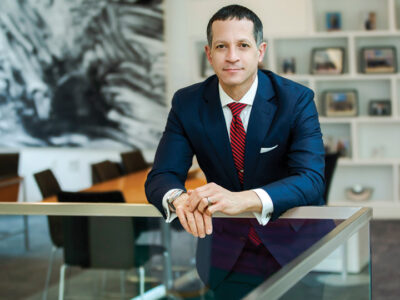
Why do young children pick up language easier than adults? One Penn linguist has some theories.
It was clear that Kathryn Schuler had a future in linguistics when, as a teenager, she marveled over her baby cousin pluralizing the word pacifier. “She was looking for more than one, and no one had to tell her to add an s,” Schuler recalls.
From that moment on, Schuler has been on a mission to understand how young kids learn language with such apparent ease—and why it’s so much harder for adults to do the same.
Now an assistant professor in the University’s Department of Linguistics and the head of Penn’s Child Language Lab, Schuler gave the final talk for the 2018–19 Penn Science Café lecture series, discussing kids and language at the Suzanne Roberts Theatre in June.
She started off by listing the assumptions she hears most: Don’t kids just imitate their parents? Don’t they learn from their parents correcting their mistakes?
Nope. Considering every language’s multitude of rules, variations, and exceptions, she notes there must be more complex processes at work than simply Mommy said that.
Her work zooms in on language variations in particular, searching to understand why all typically developing kids will learn and match predictable variations in a language—for instance, dropping the end g from “going” in casual conversation—but know to filter out or regularize unpredictable variations that they hear, such as a non-native speaker’s mistakes. And why adults do the exact opposite, struggling to master predictable variations in a new language but repeating the errors they hear.
Inside her Child Language Lab at Penn, which opened in 2017, she’s been testing three hypotheses to figure out how kids perform their language-learning magic.
Schuler’s first theory is that kids decide a certain language variation is important because they hear it frequently in social contexts. Her second focuses on the idea that kids can tell which of their adult language models are “reliable” and which are prone to making mistakes. Third, she thinks kids probably notice whether their entire community shares a certain variation, which shows them it must be important.
But why aren’t adults able to achieve the same results? “My burning question underneath everything is: Is it something about their brains?” says Schuler, who has a PhD in neuroscience from Georgetown University.
Our brains hold two types of long-term memory: procedural (knowing how) and declarative (knowing that). Researchers believe that native language rules are filed away in the basal ganglia under procedural memory, while words go into the declarative memory in the hippocampus.
“The most interesting part, which is a little less researched, is that procedural memory and the basal ganglia circuit itself peak in childhood,” Schuler says. This explains why it’s easier for kids to learn a new instrument (a knowing how) than it is for adults. Adults, meanwhile, have an edge in declarative memory. Just ask an adult to recite back a shopping list; then try asking a toddler.
Schuler says researchers have found that adults learning a second language appear to store both its rules and words in their declarativememory, while native speakers file the rules in their proceduralmemory and words in their declarative memory.
“I think maybe even in our lifetime, we might figure out whether or not this is the case,” she says. “And we might be able to find a way we can force adults back into using their procedural memory circuit so they can achieve higher levels of proficiency. That would be the dream.”
At her lab, Schuler studies the preschool through elementary school crowd—ages three to 10, roughly. Since arriving at Penn in 2017, she’s built a small team that includes a graduate student, several undergraduate research assistants, and a student illustrator who draws the stimuli for her studies. A first-generation college student herself, Schuler is hoping to increase STEM opportunities for under-represented groups, starting in her own lab.
“There are a lot of challenges that face students like I was,” she says. “A lot are financial, and we ignore them more than we should. I’m trying to make sure the opportunities to work in my lab are truly open to anyone.”
She wants her studies to be open to anyone, too—not just families who can bring their kids in at 3 p.m. on a weekday.
“It’s really important to me that we are looking at language development not just in a certain kind of child, but as something that generalizes to all kids,” she says. One solution she’s devised so far: online studies via video chat.
In spite of continuous, daily investigations by her lab and others, Schuler says it’s clear that the answers to how we learn language aren’t fully graspable just yet. “We still don’t know how our brains do it or why kids are so good at it,” she says. But whenever researchers do figure it out, she believes the results will have broad applications.
“Language disabilities and language delays are really common,” she says. “One thing that’s preventing us from treating them well is that we don’t even know how [language acquisition] works in typically developing kids. Hopefully, the work we do can help with that.”
—Molly Petrilla C’06




